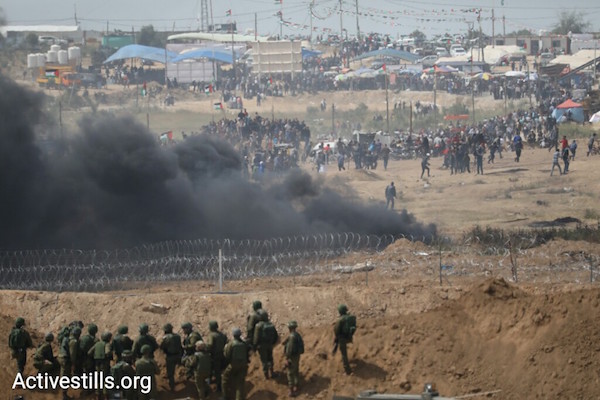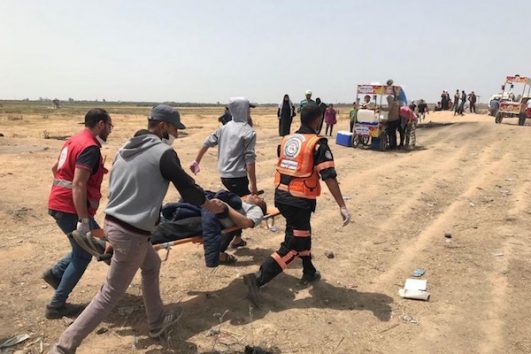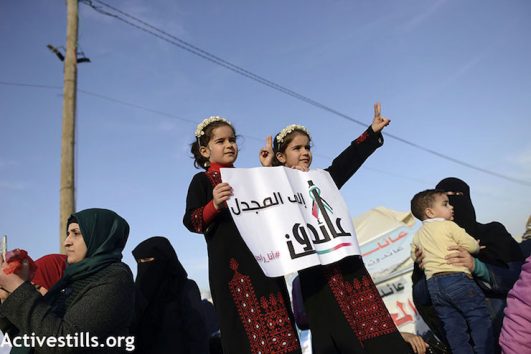Several thousand Palestinians protest as part of the Great Return March, now in its third week. Over 100 injured by Israeli sniper fire.

Update: 6:35 pm
The Palestinian Ministry of Health in Gaza is reporting that 701 people have been injured during the Return March protests. 17 of those injured are said to be medical personnel.
Update: 5:30 pm
The Palestinian Ministry of Health is reporting that over 500 Palestinians have been injured during today’s protests, 122 by live fire.
[This post is being updated as events unfold.]
Israeli snipers opened fire on thousands of protesters participating in the Gaza return march on Friday. Friday’s protesters are part of the Great Return March, a 45-day series of events planned to culminate on May 15, Nakba day.
The number of protesters was smaller than the previous two weeks, with the demonstrators spread out across five different locations along the fence that separates Israel and Gaza. Some protesters burned tires, Israeli flags and threw rocks. The IDF claims some of the protesters also threw Molotov cocktails and an explosive device.
Friday’s demonstration is the third consecutive week Israeli snipers have opened fire on unarmed Palestinian protesters in Gaza.
Since the Great Return March began, Israeli sharpshooters and snipers have shot over 1,000 unarmed Palestinian protesters, killing more than 30 people. Last Friday, at least six Palestinian journalists were reportedly among those shot at the Great Return March. One of them, Yasser Murtaja, a photographer for “Ain Media” who was reportedly wearing a helmet and vest clearly marked “PRESS” when he was shot, later died of his wounds.

Despite international criticism and calls for an independent investigation into the killings, Israeli authorities have doubled down on the decision to use live fire against unarmed protesters. In a newspaper ad campaign published last week, human rights group B’Tselem urged Israeli soldiers to refuse orders to open fire on protesters.
Following last Friday’s protests, the chief prosecutor for the International Criminal Court Fatou Bensouda warned that “violence against civilians — in a situation such as one prevailing in Gaza” could constitute war crimes.
Inside Gaza, Palestinians built a tent encampment with different tents corresponding to the various villages and towns that were destroyed during the Nakba (in Arabic, the catastrophe), in 1948. During the 1948 war and its aftermath, more than 700,000 Palestinians were expelled or fled from their homes and Israel subsequently destroyed almost all of their homes and villages.

Some 70 percent of the Gazan population are refugees, meaning they or their grandparents fled or were expelled from towns, villages, and cities inside the territory that become Israel in 1948.
Speaking to +972 Magazine before the first day of protest last month, one of the ‘Great Return March’ organizers, Hasan al-Kurd, explained that the plan was to set up camps between between 700-1000 meters from Israel’s border fence, outside the Israeli army’s unilaterally imposed buffer zone. In the weeks leading up to Nakba Day, there will be marches and bicycle races and other events every week, aiming to draw more attendees along the way. By mid-May, they hope hundreds of thousands will join.
“We want families. We want to live in peace — with the Israelis,” al-Kurd said. “We will make sure the protest doesn’t escalate to violence — at least from our end.”
Even before the march began, however, Israeli security forces launched a public campaign painting the ‘Great Return March’ as a violent, Hamas-sponsored event. The Israeli army’s chief of staff announced the deployment of 100 snipers and several infantry brigades to the area of the Gaza border fence. Israeli generals warned that there would be casualties.
On Land Day and Nakba Day in 2011, thousands of Palestinians from Lebanon, Syria, the West Bank and Gaza, and inside Israel marched on the country’s borders. On the Lebanese, Syrian, and Gaza borders, the army responded with gunfire, killing dozens and wounding hundreds.
